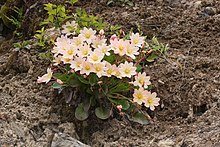Tweedy's pussypaws
| Lewisiopsis | |
|---|---|
 |
|
| Scientific classification | |
| Kingdom: | Plantae |
| Clade: | Angiosperms |
| Clade: | Eudicots |
| Order: | Caryophyllales |
| Family: | Montiaceae |
| Genus: |
Lewisiopsis Govaerts |
| Species: | L. tweedyi |
| Binomial name | |
|
Lewisiopsis tweedyi (A.Gray) Govaerts |
|
| Synonyms | |
|
Lewisia tweedyi |
|
Lewisia tweedyi
Cistanthe tweedyi
Calandrinia tweedyi
Lewisiopsis tweedyi is a flowering plant and sole species in genus Lewisiopsis. The species, formerly known as Cistanthe tweedyi and Lewisia tweedyi, is now classified in the Montiaceae family. The plant is known by the common names Tweedy's pussypaws, Tweedy's lewisia, or Tweedy's bitterroot. It is endemic to western North America in north-central Washington and adjacent British Columbia. It commonly grows on well-drained slopes often on rocky slopes or in rock crevices from low elevation ponderosa pine sites up to the drier part of the Grand Fir zone of the North Cascades. The flowers usually have a coral, apricot, or pink color.
Lewisiopsis is endemic to the Wenatchee Mountains and Methow Valley of Washington State, and in Manning Park of British Columbia. Populations may be found near Mount Stuart, Tumwater Greek, Chumstick Creek, as well as at the top of high ridges. It is one of the regions showiest herbaceous plants. It has a limited geographic range but is quite common within that area.
Lewisiopsis is perennial. It is typically found at elevation of 1,500 to 4,500 feet (460 to 1,370 m). It hides from the sun at low elevations and can be found in the shade. As the elevations increase, the plant reveals itself to the sun. It can live up to temperatures of 100 °F (38 °C) in the summer time. In its native environment, Lewisiopsis can handle temperature below 30 °F (−1 °C) degrees, although the flowers may die.
The nursery trade has taken some interest in cultivating Lewisiopsis because it is perennial, has showy blooms and it is drought tolerant. In wet climates, if the root crown of the plant gets wet, it will die causing the death of the entire plant. If cultured, perfect drainage is required for survival. The use of broken or crushed rock mixed with humus will keep the plant alive. Placing a small rock under the crowns can prevent the crown from getting wet. The plant will not die of thirst because the leathery leaves and roots will store enough water.
...
Wikipedia
